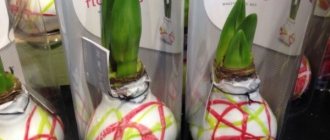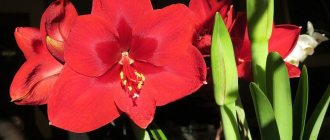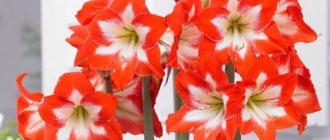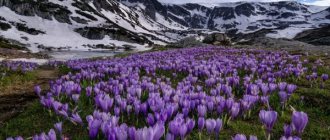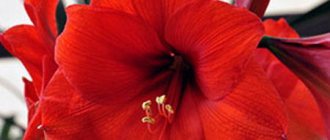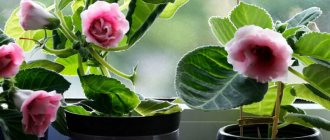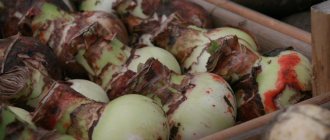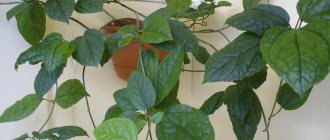Differences and similarities between hippeastrum and amaryllis
Hippeastrum, amaryllis - all these are amaryllis plants. As a rule, many novice breeders confuse them. This is because they are very similar to each other. Moreover, this similarity is not only external. Even caring for such plants should be almost the same.
The main difference between hippeastrum is that with proper care it thrives twice a year.
To distinguish these indoor plants and learn how to properly care for them, you should first consider their main features and become familiar with the most common varieties of amaryllis and hippeastrum.
Reproduction - methods
The easiest way to obtain new plants is to separate the children. The procedure is performed at the time of transplantation. Small onions, at least 2 cm in diameter, are separated from the mother bulb.
If the variety does not produce children, the crop can be propagated by dividing the bulb. To do this, you will need to cut off the foliage, trim the roots and divide the bulb into 2 parts. Each of them should have a part of the bottom with roots. The sections are powdered with coal, left for 2 days to dry, then planted in the soil.
When propagating by scales, the bulb is cut into 8-10 parts. Each part with a bottom is sprinkled with activated carbon, dusted with a root formation stimulator and planted in moss or sand.
Hippeastrum seeds have a short shelf life, so they are buried in the soil to a depth of 1 cm immediately after collection. The advantage of this method is the production of new, beautifully flowering plants, because those propagated by seeds do not repeat the characteristics of the mother plant.
Main types of hippeastrum
After reaching a height of 10 cm, the Hippeastrum sprouts should be transplanted into a solid container.
Hippeastrum represents about 90 species. But at the same time, only a few are grown in peaceful conditions. However, even some breeders are trying to learn how to grow wild hippeastrums.
The most common is the Hippeastrum Palace. In nature, this flower grows mainly in Paraguay and Brazil. This is a typical epiphyte whose roots really enjoy a constant flow of fresh air. Therefore, it grows like a vine, entwining the crown of trees and other large plants with a high trunk. The flowers of this plant are very similar to lily flowers. They are distinguished by a bright red color and appear along with the leaves.
Argentine hipeastrum is very rare among florists. And in the wild it grows only in Argentina, and then in small quantities. It has high momentum and at the top you can see a beautiful bouquet of three snow-white, lightly pressed flowers. Since this plant loves subtropical climates, it can only be found on high hills.
A very interesting option is narrow-leaved hippeastrum. This plant can be found in the wild in southern Brazil. This is a very large plant with large leaves and flowers.
This narrow-leaved hippeastrum blooms very beautifully: huge red buds open into 9 pieces at a time, creating an elegant bouquet. The plant loves moisture, so it is mainly found in swamps. Potted varieties of this type are very receptive to moist soil and air.
Artificially grown varieties of hippeastrum are still very popular among gardeners. The Rosalie variety is considered very beautiful. The plant features elegant, delicate pink flowers that bloom every spring in the painting. The Evergreen class is considered one of the most elegant. The plant produces very beautiful buds. The flowers are white-green, the petals are narrow, slightly pointed at the ends and curled. This plant can produce up to 14 buds at a time if it provides good conditions.
Hybrid Hyppeastrum varieties Marilyn Monroe are not considered very fashionable for growing indoors. But at the same time, the plant is distinguished by delicate white flowers, the petals of which are rounded. Usually you get the same number of buds, but the bouquet always looks very elegant and neat.
Crossbreeding ability
Hippeastrum flower - care at home and in the open ground
Amaryllis crosses well with other species, for example, with Crinum, Nerine or Brunsvigia. Hippeastrum, in turn, is practically incapable of crossing; in 90% of cases this is impossible.
Amaryllis in the wild
Despite this, the varietal diversity is very large and numbers almost 2000 varieties, about 200 of them are the most popular. The most common are representatives of the Leopold hybrid group.
Amaryllis species
Amaryllis is grown only in peaceful conditions.
In Amaryllis, the entire genre is represented by only one species - Amaryllis Belladonna. However, using the method of selection, it was possible to develop another very beautiful variety - Amaryllis Sarniensis. Both of these species are very beautiful and are often grown indoors.
Amaryllis Sarniensis growing in a peaceful environment is not that difficult if you follow one important but simple rule. First, let the onions germinate in a greenhouse until the stem begins to grow, and then plant the plant again in a solid container. While the leaves are just beginning to grow, the plant is already beginning to produce its first buds. For this, many people love this plant.
Amaryllis belladonna is considered the most popular to grow indoors. The flower grows high (up to 0.5 m), but at the same time produces many pink or white buds. Surprisingly, this variety blooms in autumn and winter, and in the summer it drops its leaves and overwinters.
Thus, the main types of hippeastrum and amaryllis are considered. And, despite the external similarity, you should still know the main differences between these plants. There are differences both in appearance and in basic scientific characteristics. Let's look at all this in more detail.
So amaryllis flowers are quite dense. At the same time, the plant can bloom from 6 to 12 buds at the same time. But in hippeastrum the flower is empty in the middle, but this does not make it any less beautiful. But in a bouquet 2-6 buds bloom at the same time. Blooming, very large flowers open to view.
Another characteristic feature is that hippeastrum flowers are always larger. They usually reach 14-15 cm in diameter. But amaryllis inflorescences are small compared to the hippeastrum inflorescences. Their diameter is only 8 cm, provided that the necessary care functions are provided.
Amaryllis flowers have no scent, but hippeastrum inflorescences always emit a very pleasant subtle aroma. In addition, hippeastrum, unlike amaryllis, always first produces thick, juicy green leaves, and only then begins to bloom. First, the amaryllis produces buds, and only then leaves appear around them.
But the main feature is that amaryllis is the only one of its kind, while currently there are only 2 species of such a plant. And there are more than 90 varieties of Hippeastrum, with even more different species.
Signs and superstitions
Hippeastrum can be found in many parts of the world. That is why a large number of signs and superstitions are associated with it. Here are some of them:
- Hypeastrum can relieve bad mood, relieve depression and fatigue, improve friendships and love relationships, and reduce irritability.
- This flower helps to realize creative abilities and is appropriate in the home of writers and artists.
- Hippeastrum is the flower of desires. Say the cherished words over the pot with the plant and wait for the result.
- Among the negative qualities of the plant, it should be noted its ability to absorb negative energy. Therefore, under no circumstances should you quarrel near a bush.
- When an unwanted guest appears in the house, you can find out his intentions. Just ask him to touch the petals and watch the plant's reaction after leaving. If the flower begins to fade, it means the guest came with malicious intent.
- If a girl is not sure of the love of her chosen one, there is such a sign: you need to ask your partner to give a hippeastrum flower and grow the plant. When leaves or a flower arrow appear, one can speak of the sincerity of feelings.
- Hippeastrum gives confidence and determination to individuals with weak energy, helps to find harmony and mental balance.
- During flowering, place the pot in the center of the room and your home will be filled with positive energy.
- This flower is recommended for single men who want romantic encounters. To do this, you need to plant the hippeastrum in a pot yourself and success with the opposite sex is guaranteed.
In order for the hippeastrum to feel good, it is necessary to provide it with proper care at home. This is not difficult to do, following the recommendations described in the article.
Rules of care
If we take into account that hippeastrum and amaryllis are almost identical, the conditions for their maintenance may also be the same.
In the Hippeastrum bulb, the scales are thin and have no scales.
This is mainly due to the same type from which these plants come. Let's consider the main features of caring for such plants in the indoor environment.
When growing such flowers, it is necessary to observe a sequence of temperature fluctuations. As soon as the bulb begins to sprout, it is necessary to place the plant in a sufficiently lit place and provide an ambient temperature of about 21-22 ° C. But during flowering, it is best to move the pot to a cooler place, lowering the air temperature to 18 ° C. This will help extend the time flowering.
As soon as the plant blooms, you will immediately have to move it to the same warm place, just avoid direct sunlight. Let it grow until the leaves begin to wilt. As soon as the last leaf has disappeared, it is necessary to transfer the flower to a cool, darkened room in which the ambient temperature is maintained at 14 ° C. Leave for 6 weeks. During this rest period, the flower will have time to gain new strength and then continue flowering.
The water that plants need is very careful. But a lot depends on the specific species. The fact is that there are very moisture-loving varieties that require constant watering. As a rule, the soil in pots with such plants dries out quite quickly.
However, most hippeastrum and amaryllis require the same watering system. It is best to first water the bubble with a small amount of clean, soft water in a saucepan. As soon as it begins to bloom, you need to slightly increase the frequency of watering and the amount of water. But don't make the potting soil too wet. Maintain moderate humidity so that the flask does not begin to hurt or rot.
Therefore, it is necessary to maintain moderate watering until the fall, until the plant begins to prepare for the rest period. Once the last flowers have faded and the leaves begin to disappear, gradually reduce the amount of water poured into the pan.
During the rest period, it is better not to water the soil at all. All you have to do is break it lightly enough to get enough oxygen to the roots. But it is not necessary for the soil in the pot to dry out a lot. After all, the light bulb may develop poorly or stop growing altogether.
Along with proper watering, the plant must be provided with nutrients. Feeding should begin from the moment the bulb begins to bloom. He should start watering the plant with liquid mineral fertilizers once every two weeks. During the flowering period, you need to switch to a special complex fertilizer for flowering potted plants.
But feeding should be stopped immediately after flowering. During the development period, the plant must have time to collect nutrients in the required quantities. You should also know that during flowering, instead of complex fertilizers, you can change organic and mineral preparations for indoor flowers.
To prevent damage to the plant, it is useful to treat the shoots and leaves from time to time with special preventive medicines against white aphids, rust fungi and thrips. Indeed, in most cases, these diseases affect such plant varieties.
Thus, the main features of the growth of hippeastrum and amaryllis are considered. It is easy to understand that such tuberous plants require absolutely the same care. And if you give them the right conditions, you can enjoy the most beautiful inflorescences every year and produce little babies from the bulbs. Some breeders deliberately breed amaryllis to create new hybrids that will be suitable for growing at home.
If you have both flowers in front of you, it is easy to distinguish amaryllis from hippeastrum. It's harder to confuse them. You can make the mistake of buying a bulb or plant without flowers. If you don't know the difference between these colors, we recommend using the following tips. MAIN DIFFERENCES: - hippeastrum bulbs are round, sometimes elongated, and amaryllis bulbs are pear-shaped; — amaryllis has a pleasant subtle aroma; — amaryllis inflorescence has 6-12 flowers, hippeastrum has up to six flowers in an inflorescence; - if your plant bloomed in autumn - then amaryllis, if in winter or spring - it is hippeastrum; - Look at the stem: if it is empty, your plant is a hippeastrum. Both plants - amaryllis and hippeastrum - belong to the Amarilli family. The botanical name Amaryllis has been attributed to Amaryllis Belladonna, all other similar flowers are called hippeastrum. Difference between hippeastrum and amaryllis: - Number of species in nature: hippeastrum. Includes up to 85 different species. Amaryllis. The only type is Amaryllis Belladonna or Amaryllis beautiful. — Where does the plant come from: Hippeastrum. Native to the American tropics and subtropics. Amaryllis. It comes from southern Africa. — Possibility of crossing: hippeastrum. In 90% of cases it cannot be crossed with other representatives of the species. Amaryllis. Crosses well with species such as: Crinum, Nerina, Brunswig. — Hippeastrum rest period. Most hippeastrums have a resting period, but there are also evergreen species. For example, Hippeastrum Papilio. Amaryllis. Deciduous. You are resting. — When it blooms: Hippeastrum. It blooms once a year, in autumn, spring, winter - depending on the beginning of forcing. Some species bloom twice a year. Amaryllis. It blooms once a year, usually flowers appear in late summer and autumn. Amaryllis after flowering. — Stem characteristics: Hippeastrum. The peduncle is cylindrical, up to 90 cm tall, hollow, green in color, and has a brown or gray tint. There are up to 15 flowers on a peduncle with a subtle aroma. Amaryllis. The tail has no indentation and is green with a purple tint. It grows to a height of 1 m and has up to 12 fragrant flowers. — Flower color: hippeastrum. Red, pink, green, yellow, white. They may be veins and dots of a lighter shade. Amaryllis. Different shades of pink. — Leaf shape and color: hippeastrum. The leaves of different species are different: smooth or hard, elongated, resembling a belt. Amaryllis. The leaves are narrow, smooth, grooved. — Flask shape: Hippeastrum. The lamp as a whole has a round, sometimes slightly elongated shape. The scales on the onion are similar to the onion, only white. Amaryllis. Pear-shaped onion. Covered with gray scales, hairy on the inside.
The amaryllis family, which includes amaryllis and hippeastrum, belongs to the class of flowering plants. These flowers have gained immense popularity as decorative flowers.
They can often be found as bedding or in the home.
Color Definition:
Help!
The amaryllis flower usually begins to bloom in late summer or early fall, while its leaves die during flowering.
Leaves
Another difference lies in the leaves. In Hippeastrum they are wide, looking like a belt with a rough surface. As a rule, there are four of them, one of which supports the arrow. Amaryllis has a narrow and thin leaf (up to 3 cm), but long.
Pay attention to the leaves during the flowering period. If we are talking about amaryllis, then during this period it sheds its leaves, devoting all its strength to gramophones. After flowering ends, the plant enters a dormant period, which usually lasts about 3 months.
Hippeastrum leaves do not interfere with flowering, but the plant periodically sheds them to rest.
Why are they often confused?
The confusion between these types of flowers began a long time ago and continues to this day - this is because:
- These plants come from the same family. Amaryllis was discovered first, and later hippeastum, and then scientists assigned it to one of the amaryllis species. Only later, after they tried to cross them and the tests ended in nothing, did scientists come to the conclusion that they were completely different plants.
- Both flowers are tuberous and grow in the same climate. They are especially often confused regarding the inflorescence because they are both umbrella-shaped. At the same time, the flowering and resting periods of these two plants are equally pronounced.
- Florists also confuse the names of inexperienced florists. Some varieties of hippeastrum begin with the words amaryllis.
- Sometimes confusion arises due to the fact that hippeastrum blooms without leaves; such flowering is not typical for it.
If you look at both flowers at the same time, they do not seem similar to each other, their differences produce the same inflorescences and stand on their own, but they are easily confused.
What is the difference: information and photos
Despite the fact that these plants belong to the same genus Amaryllis, they have many special characteristics. It is not difficult to find the differences between amaryllis and hippeastrum if you pay attention to the photos below and the “Differences” table.
| Differences | Amaryllis | Hippeastrum |
| Genus | Has only 1 type. | There are more than 90 species. |
| Origin | Brought from Africa. | Artificially produced. |
| Appearance | The bulbs look like a pear, smooth. Daughter bulbs can often be seen. | The bulbs are slightly elongated, round, scaly. There are almost never daughter bulbs. |
| Care | Tolerates cold well. | Does not tolerate low temperatures. |
| Growth and flowering | It can be grown both in the garden and on the windowsill. Seeds germinate in 8 weeks. During flowering, which occurs only once a year, there are no leaves on the stem. A pleasant aroma emanates from the inflorescences. | It can only be grown on a windowsill, on the south side. Seed germination is observed after 2 weeks. The plant blooms several times a year. Flowers have virtually no scent. |
You can find out about the reasons for the lack of flowering and how to stimulate the appearance of buds here.
In the photo there is an amaryllis flower:
And this is hippeastrum:
Who cares?
The differences between these plants can be presented in a summary table:
| differences | Amaryllis | Hippeastrum |
| Differences between types | It belongs to the genus Amaryllis and is defined by only one type, Amaryllis belladonna. | It belongs to the genus Hippeastrum. So far, there are about 90 species of this plant. |
| Differences in origin | Plants native to southern Africa. | It comes from the tropics and subtropics of America. |
| Differences in appearance | This is an onion plant; the size of the bulb can reach 6-10 centimeters in diameter. Green Leaves Leaves are absent during flowering. The inflorescences of this plant form 2-12 flowers, the size of which is approximately 7-10 centimeters in diameter, the flowers consist of 6 petals. The flowers are white, red, pink and purple. The stem of this plant is fleshy. | The tuberous plant, its bulb, is a turnip measuring 5-10 centimeters in size. The leaves of the plant are long green, their size and shape, and the shade depends entirely on the species. During flowering, this plant's inflorescences can form from 2 to 5 flowers with a diameter of 15-25 centimeters. Flowers have 6 petals. This plant, depending on the subspecies, has many flowers of any shade. |
| Difference in growth and flowering | Amaryllis takes about 56 days to grow from seed. At home, flowering occurs in the fall, and the rest of the time the flower rests. | Grows from seeds in two weeks. Flowering begins in winter and can last until spring. |
| Differences in home care | It does not require special care. This flower does not like excessive humidity because it can cause fungal diseases. Before flowering, this plant must be at rest. To do this, place them in a dark place in the summer. | This flower is not capricious. He does not like frequent watering. To get good blooms within a month, you must calm the plant by placing it in a dark place. |
Attention!
Both plants are susceptible to fungal diseases. To avoid this, good soil drainage and regular moisture monitoring are necessary.
Difference in species diversity of flowers
Hydrangea paniculata and tree-like - differences
Amaryllis has only four species, called Amaryllis belladonna, Amaryllis bagnoldii, Amaryllis condemaita, Amaryllis paradisicola. At this time, the hippeastrum has about 90 species, which often differ significantly from each other.
It is worth noting! Taxonomists may also confuse these two plants; previously the genus Amaryllis included many more species, but later the majority were transferred to the genus Hippeastrum. Hybrid hippeastrum constantly has new varieties that delight flower growers with their beauty. They tolerate diseases better and are generally less susceptible to them.
Description and comparison of plants
Both heat-loving houseplants have a flowering phase and a dormant period. That just about completes the exotic flower resemblance.
You know? Amaryllis name comes from the shepherdess, the heroine of Virgil's line, the Greek meaning
"
shine
"
.
It blooms once a year, in the open air, maybe twice. Usually in August ─ early September. Flowers are collected in inflorescences of 6-12 pinwheels with a delicate aroma. The color changes from the light tones of the bowl to the dark rim. The stem is fleshy and juicy. Absent.
Flowers can be seen up to four times a year, depending on bulb size and care. An empty, tall stem with 2-6 flowers with a diameter of 25 cm is surrounded by dark green arrow-shaped leaves. There is no smell.
Popular varieties of indoor hippeastrum with photos and names
Among the varieties there are miniature hybrids, as well as those with long-tubular, orchid-like, double and simple flowers.
Leopold
The most common variety. A white border runs along the edges of the pink petals. Toward the base, the white edge turns green.
Lady Jane
The flowers are large, double, and peach-colored. There is a pink vein running down the center of the petals. The flowers reach 20 cm in diameter.
Spotted
The variety first produces flowers, then leaves. Red spots are randomly scattered across the cream petals. The throat is colored yellow-green.
Regina (Royal)
The flowers are deep red, the peduncle is 50 cm long. The foliage appears after flowering.
Narrow-leaved
Based on the name, the variety has long, narrow leaves. Petals are orange. Up to 9 flowers can bloom simultaneously on one peduncle.
Difference between clans
At first glance, similar plants differ. Knowing the difference between each flower, you will not be able to confuse them.
By origin
Amaryllis is native to Africa, South Africa. The first mention of the flower dates back to 1737. In catalogs of that time, the flowers were called lilionarcissi. Only one species is known in nature. ─ Amaryllis is beautiful, grows indoor flowers ─. In 1821, British poet and botanist William Herbert described the differences between Hippeastrum, identifying the origins of the African continent. The flower has more than 90 types of different colors: white, orange, pink, with contrasting stripes along the edges.
It is important! Amaryllis is less common in the sale of the more popular hippeastrum. Both flowers are the pride of the internal plant collection.
By appearance
The different “looks” of amaryllis and hippeastrum help to quickly distinguish plants:
- the stem of hippeastrum is always surrounded by thick green leaves;
- amaryllis has no leaves during flowering;
- In an inflorescence, amaryllis has up to 12 gramophones, which fade within a week;
- in hippeastrum ─ no more than 6 flowers per shoot, if you cut it and change the water every day, the flowers will last 10-12 days;
- Amaryllis blooms for 30-40 days, for Hippeastrum two months;
- after flowering, smooth, narrow amaryllis leaves appear, which serve as a supplement to plant nutrients;
- The amaryllis bulb is pear-shaped, with scales. There are nets under the scales;
- in hippeastrum the onion is round, slightly flat, with light scales without hairiness.
Both plants produce onions, scales, children and seeds.
Flowers have a resting period and a vegetative phase:
- in hippeastrum, the growing season begins at the end of winter and lasts until late autumn.
If the flower has enough nutrients, the room temperature remains warm, the hippeastrum cannot rest. To rest, stop watering and place in a cool room. Long arrow leaves accompany the flowering time; - Amaryllis dissolves a bright inflorescence at the end of summer, the flowering time
is up to one and a half months. Sometimes flowers growing in open ground enjoy beautiful buds twice a year. The leaves begin to grow only after flowering begins; they serve as an additional source of nutrients.
To grow your own, it is better to buy onions in a specialized store, in branded packaging. This way you can avoid the mistake of misleading plants. Light bulbs do not require a lot of care and maintenance. Without exception, hippeastrum and amaryllis.
Growing amaryllis
Plant the onions immediately in a sturdy pot. The soil is poured onto two-thirds of the onion, leaving an open part. At a temperature of +20 ... + 25 ° C within two years the plant will produce its first inflorescences. Water the flower when the soil is dry, at the edge of the pot, not at the onion. Around the start of the growing season, a warning will appear about the appearance of the arrow in March.
Watering should be stopped until the arrow reaches 10 cm. The growing season ends when the inflorescence dries out and the leaves grow. You don't need to cut them. They fertilize the flowers and continue to water regularly for two months, gradually increasing the interval between waterings. . At the end of February, the pot with flask is placed in a bright place at + 25 ° C to awaken to the new vegetative phase.
It is important! They do not need to replace perennial tuberous plants every year.
Growing hippeastrum
An old hippeastrum will bloom 6-8 weeks after planting in a pot of moist soil. Until the sprout appears, there is no need to water the plant. The main condition for good growth and rapid flowering: room temperature and a bright room. The larger the bulb, the faster the flower will “wake up,” not to mention the inflorescence. Amaryllis and hippeastrum are indoor tuberous plants with huge flowers that grow on a thick, hollow stem. The number of peduncles (arrows) and flowers on them depends on the size of the bulb.
Large bulbs can form 1-2 stems, on which up to 12 large bell-shaped flowers of white, pink, red flowers can grow, which form large inflorescences.
Amaryllis is a warm-loving plant native to South Africa. It does not grow outdoors because it does not tolerate the slightest frost.
Hippeastrum and amaryllis - these two plants are often confused because they are very similar. Their flowering period is different, which sets them apart. Amaryllis blooms in autumn - the flowers smell good, and hippeastrum blooms in winter or spring - the flowers have no smell.
Another feature that distinguishes these 2 plants is the number of flowers on the base: in hippeastrum there are up to 6 flowers, and in amaryllis there are from 6 to 12 flowers on one stem.
These two beautiful flowers can also be distinguished by their light bulb shape. Amaryllis bulbs are pear-shaped and quite large. Hippeastrum bulbs are more round and somewhat flattened, but it is difficult to distinguish one bulb from another. In order not to make a mistake in choosing light bulbs, it is better to buy them in specialized stores in the manufacturer’s original packaging. The bulbs of these plants can be stored for a long time in a dry place. Amaryllis is represented by the only species Amaryllis belladonna, it is very rare, plants sold under the name "Amaryllis" are actually hippeastrum.
The hippeastrum hybrid is very beautiful, the flowers come in different colors: orange, white, pink, red, and there are also stripes with different colors along the edge or along the petals.
Genus and origin of flowers
Both flowering crops belong to the same amaryllis family, but have different genus. Hippeastrum is famous for its rich varietal diversity; it has about 90 species. But amaryllis only has one.
As for the origin, the birthplace of amaryllis is Africa; it was on this continent that the flower was first discovered, and then transported to European countries.
Hippeastrum was created artificially; the bulbs of its ancient representatives were brought from the subtropical zone of the earth.
Caring for onion plants indoors
Amaryllis for caring for flowers and hippeastrum does not require much effort.
Watering
. Tuberous plants should be watered very rarely during rest, and the soil should not dry out. Amaryllis and hippeastrum do not tolerate stagnant water. It is absolutely impossible to water the plant from above, since excess water gets inside the flask, which leads to its decomposition. Pour water onto a plate or place a light bulb on it. Fertilization of amaryllis and hippeastrum during sleep is not necessary.
Air temperature
. In the case of Amaryllis and Hippeastrum bulbs, the air temperature should be moderate - up to + 20 ° C, but not lower than + 10 ° C.
Transplantation and reproduction
. Amaryllis is a perennial plant and does not need to be replanted every year. It is only necessary to replace the top layer of soil so that the previous soil level is the same (do not fill higher than the previous level). You can repot the plant every 2-3 years or when you need to separate the babies and place them in a separate pot. An adult bulb removed from an old pot should be cleaned of rotten roots and dry or rotten scales. The prepared onions are planted individually in a pot, but the soil level should not exceed 2/3 of the height of the onion (do not fill the entire onion). Choose a small but wide pot, only 3 cm, with enough space around the bulb.
During propagation by daughters, the plant will bloom in the third year; when it grows from seeds, it blooms in the 7th year. Take care of amaryllis and hippeastrum during active growth
At the beginning of the growing season, the plant will “tell you itself”: an arrow, a stem, will begin to grow from the bulb. Amaryllis blooms in a leafless state. Leaves appear only during flowering. Hippeastrum retains green leaves throughout the year and shoots out an arrow at the beginning of the growing season.
Air temperature
. The air temperature for amaryllis and hippeastrum during the growing season should be moderate: + 20 + 25 ° C. The light should be bright, but direct sunlight should be avoided.
Watering
. It is not advisable to water the plant at the beginning of the growing season. Until the arrow reaches a height of 10 cm, amaryllis and hippeastrum do not need to be watered. When watering, at the beginning of the growing season, the arrow will grow slowly, the leaves will grow, the bulb will have little strength to flower. After reaching a certain frog height, the plant is watered because the top layer of the clay lump dries with warm, soft water along the edge of the pot to prevent water from falling onto the bubble.
Fertilizers
. It is necessary to begin fertilization of the plant during the growth of the arrow. Feed the flower once every 14 days with mineral fertilizer for flowering plants.
Care after flowering
. At the end of flowering, when the stems dry out, a state of dormancy occurs, the leaves should not be cut off and the plant is fertilized for some time (30 days). Fertilizers and watering are then reduced, and after 2 months they are watered only sporadically. The flower comes to rest. The desired temperature during this period is cool, but not lower than + 10 ° C. At the moment, a bright light bulb is not required. The rest period lasts up to 6 months.
Blooming amaryllis at home
Amaryllis in the wild enters the flowering phase in early autumn. In indoor floriculture there are tricks on how to change this period. The easiest way is to plant the bulbs at a different time. So, when choosing healthy specimens, they begin to grow immediately after planting, producing mature peduncles already in 7-8 weeks. Here you need to observe - if there are more than two peduncles, they are removed so as not to overload the bulb with flowering.
When the first flower appears and blooms, some cut off the peduncle and place it in a vase. Provided the water is updated daily, it can last there for up to three weeks. You don’t have to cut the peduncle, but it will last just as long and will deplete the bulb much more. To maximize flowering time, place the vase or pot of flowers in a cooler, darker location.
Table: conditions of detention depending on the season
| Season | Temperature | Lighting | Accommodation |
| Spring and summer | The temperature should be within +17…23 °C | The plant requires bright but diffused light. It needs to be shaded from the scorching sun | The container with the plant should be placed on a south-eastern or southern windowsill |
| Autumn and winter | The optimal temperature during this period is +10…15 °C | Hippeastrum does not require shading or additional lighting during this period. | It is recommended to move the pot to a cool, shaded place |
Story
These flowers were first mentioned in Europe in 1737 in professional plant catalogs. They were originally called daffodils and lilies. The genus Amaryllis is based on descriptions of specimens first brought from South Africa. Subsequently, specimens brought from America began to be classified as this species.
Botanist W. Herbert in 1821 identified the main differences between African Amaryllis and plants from America. The new genus became known as Hippeastrum. It should be noted that Amaryllis beautiful is the only species; all other hybrids and varieties are called hippeastrum, or hybrid hippeastrum. This is exactly the order established at the International Botanical Congress, held in 1954.
Amaryllis were brought to St. Petersburg in the middle of the 19th century, and in 1936 a nursery was created in Adler, where their bulbs began to be grown. Breeding work began at the Estonian Institute of Experimental Biology in 1953.
Diseases and pests of hippeastrum with photos and their treatment
Pests that damage hippeastrum:
- onion mite;
- amaryllis mealybug;
- false scale insect;
- mealybug.
Insecticides are used to control parasites. If you don't get rid of insects, they can become carriers of diseases:
- root rot (fusarium);
- stagnospora;
- anthractose.
Fungal diseases are treated with Fundazol and Bordeaux mixture. But before treatment, the diseased plant is isolated from healthy ones.
